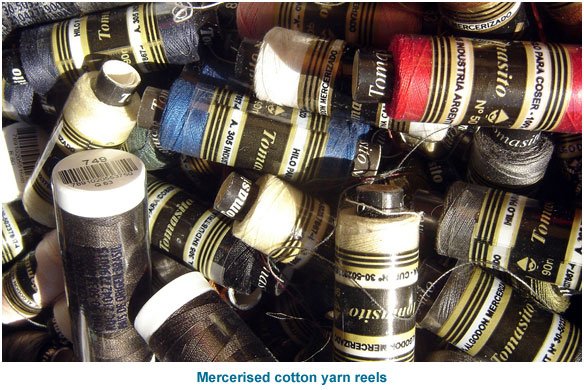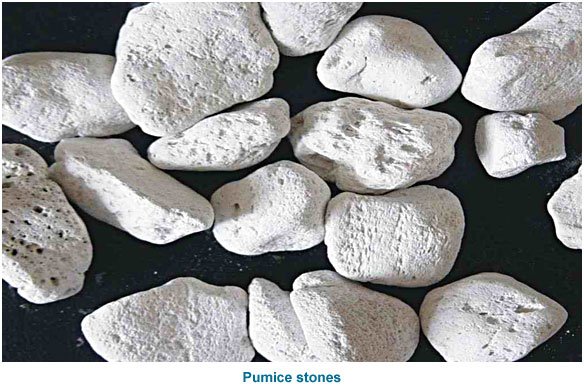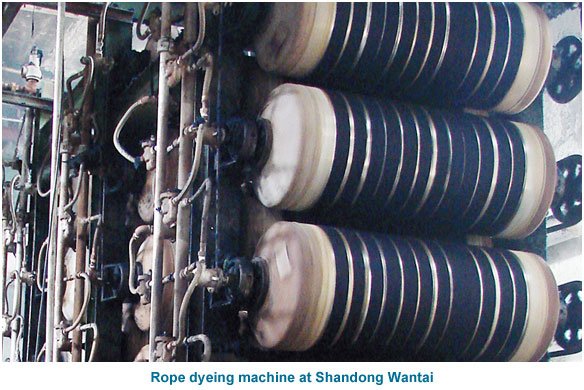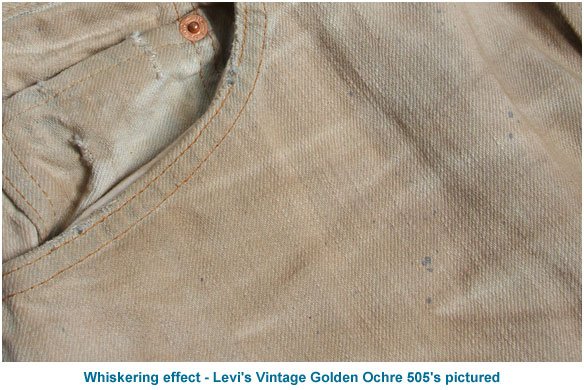Denim Glossary - Washes and Finishing Process
The ultimate display of detail is found in true vintage denim. The story of each wearer has been indelibly recorded on each pair- each abrasion pattern, area of wear and whiskering, each grease stain are tell tale signs of what each pair has lived through. To achieve this effect naturally takes years of wearing in dry denim without washing- the patinas created through wear are completely personal to you and tell a very special story.
This also takes a great deal of patience. A lot of blood sweat and tears has gone into discovering techniques to speed up denim aging and wear processes that produce a naturally vintage look. The majority of this very skilled work is done by hand and the process is very time consuming.
A
ABRASION
Process of making garments look worn and aged by scraping or rubbing the surface of the fabric causing abrasion. Pumice stones are most frequently used by industrial laundries.
ACID WASH
(Marble/ Moon Wash/ Snow Wash)- This finish gives indigo jeans sharp contrasts. The process is achieved by soaking pumice stones in chlorine and letting these stones create contrast. The process was created in Italy and patented in 1986.
ATARI
Japanese term describing the selective fading of the ridges of creases. The most common areas for 'Atari' are along side seams, on the front and back of the knees, the upper thigh, along the hem, on belt loops and along pocket seams.

B
BLEACH
A chemical used to make denim fade. Liquid bleach is usually an aqueous solution of sodium hypochlorite, and dry powdered bleaches contain chloride of lime (calcium hypochlorite).
C
CAST
A term that describes shading. Depending on the method and type of dye used, indigo denim can have a black, brown, gray, green, red, or yellow cast to it.
CELLULOSE ENZYME WASH
Enzymes which are like yeast , are used to physically eat away the cellulose in cotton. Since the colour in denim fabric is actually on the outside of the yard, when the denim is washed in a cellulose enzyme bath the indigo is removed along with the fiber. When the desired colour has been achieved, either changing the alkalinity of the bath or heating the water stops the enzymes from reacting. A rinsing and softening cycle follows. This process is more environmentally friendly than stone washing because strip-mined pumice stones are not used.
D
DESIZING
An amylase enzyme rinse (desize) used to soften denim. A type of size such as cornstarch is added to the warp yarns prior to weaving in a process called slashing, which adds stiffness to the yarns. During the desizing step, the amylase enzyme attacks the starch and removes it from the fabric. Although this process reduces colour slightly, it is primarily used to give a softness and drapability to denim.
DIPS
Used to describe fabric or yarn when they are immersed in dye. Indigo yarns are usually dipped in an indigo bath six times.
E
ENZYMES
Enzymes, which are proteins present in all living cells, speed up chemical processes that would run very slowly if at all. They are non-toxic and readily broken down. Enzymes are used in textile processing, mainly in the finishing of fabrics and garments.
ENZYME WASH
Considered a more efficient and environmentally sound way to stone wash jeans. Rather than using pumice stones, organic enzymes (proteins) are used that eat away at the indigo. Jeans finished using enzymes tend to be stronger than those broken down by traditional stone washing, as the fabric is not subjected to the same level of abuse.
F
FINISHING
The techniques or processes performed on a garment, which give it its unique look.
G
GARMENT DYE
A dyeing process performed on finished garments, as opposed to a yarn dye, which takes place prior to the weaving of yarn. If you see pocket linings or labels that look the same colour as the self-fabric, the garment was likely garment dyed.
H
HAND
A description of the way a fabric feels. A subjective judgement of the feel or handle of a fabric used to help decide if a fabric is suitable for a specific end use. The hand can be described as crisp, soft, drapable, smooth, springy, stiff, cool, warm, rough, hard, limp, soapy etc. Finishing and garment wash will affect the final hand of a fabric.
HANK DYEING
This is a very special dyeing process that very few people use. The yarns are loosely arranged in skeins or hanks. These are then hung over a rung and immersed in a dye bath being dipped in and out and left to oxidize in the air between each dip giving the yarns a natural irregularity of patina and caste. In this method, the colour penetration is the best and the yarns retain a softer, loftier feel.
I
INDIGO
The dye used for denim, initially taken from the indigofera tinctoria plant. It was synthesized 14 years after it's chemical structure was identified by Adolf Bayer in 1897. Indigo's inherent features are good colour fastness to water and light, a continual fading and it's inability to penetrate fibers completely. This allows the blue colour in jeans made dyed with indigo to always look irregular and individual. Pre-1920's jeans were generally dyed with natural indigo and were- as far as one can tell by comparing vintage examples- paler in colour, with a green cast. Later jeans were a darker blue, particularly used in combination with sulphur dyes. The majority of indigo used today is synthetically made. Natural indigo has a slightly red cast.
IRO-OCHI
Japanese term referring to the fading of indigo dye in denim. The term specifically relates to fading in exposed areas and not across the entire garment.
L
LAUNDRY
In the 'Denim Industry', a Laundry is a manufacturing company that takes unwashed jeans and processes them. This processing includes washing, stone washing, sandblasting, garment dyeing, finishing, use of 'Tonello' machine with abrasive bristles, applying enzymes to simulate a 'whisker' effect and sandpapering by hand. Laundries today are critical in making jeans look commercial and wash development has become as important as fabric development in the denim industry. The best Laundries and wash developments come from the U.S, Japan and Italy.
LOOP DYED
One of the three major industrial methods of dyeing indigo yarns. In the loop dyeing process, the yarn is dyed in a single bath instead of several. The desired depth of colour is attained by passing the yarn through the vat several times. Subsequently as part of the same process, the yarn is sized.
M
MERCERIZATION
An industrial process used on yarn or fabrics to increase it's lustre and dye affinity. For fabrics used in the denim industry, mercerization can be used for keeping dye on the surface of the yarns or fabrics and to prevent dyes from fully penetrating the fibres.

MICROSANDING
In this fabric treatment process, a series of cylindrical rolls in a horizontal arrangement, either wrapped with an abrasive paper or chemically coated with an abrasive , are used to create a soft, sueded hand. The denim is pulled over the face of the sand rollers creating a raised surface finishinig. Some colour reduction is experienced.
O
OVERDYE
A fabric dyeing process in which additional colour is applied to the fabric or garment to create a different shade or cast. 'Dirty Denim' is often created by applying a yellow overdye to denim. By localising the application of the tint, you can create specific areas that look dirtier than the surrounding areas.
OXIDATION
Occurs when oxygen and another substance chemically join. This occurs when indigo yarn comes out of the bath between dips.
P
PIGMENT DYES
Dyes that do not have an affinity for fibre and must therefore be held to the fabric with resins. They are available in almost any colour and are used extensively in the denim industry by fabric dyers who want to create fabrics that fade more easily.
PUMICE STONES
Volcanic stone used for stone washing garments. Pumice is popular because of it's strength and light weight. Before the use of pumice, rocks, plastic, shoes and just about every other material was used to wear down and soften denim during the laundry process.

R
RING DYEING
Describes a characteristic unique to indigo dye in which only the outer ring of the fibres in the yarn is dyed while the inner core remains white.
RIVER WASHING
A washing process using a combination of pumice stones and cellulose enzymes to give denim a vintage, worn hand. The washer is loaded only with stones and fabric for the first cycle. Enzymes are introduced for the second stage in combination with the stones and they are tumbled until a naturally aged look is produced.
ROPE DYEING
Considered the best possible method to dye indigo yarns. The threads of denim yarn are twisted into a rope, which is then fed through sequence of being dipped into a bath of indigo dye, followed by exposure to air, multiple times. The frequency determines the ultimate shade of blue.

S
SANDING/EMERSING
A fabric finishing process where fabrics are sanded with real sandpaper to make the surface soft without hair. It can be performed before or after dying.
SANFORIZATION
A pre-shrinking fabric process that limits residual fabric shrinkage to under 1%. The process includes the stretching and manipulation of the denim cloth before it is washed. Raw, un-sanforized jeans will shrink 7-10% after the first wash, and continue to shrink slightly up to the third wash. Developed in the late 1920s by the Sanforize Co. and patented in 1928, the process was reportedly first used by Erwin Mills in 1936 to make denim for overalls marketed under JC Penney's Big Mac label. Lee jeans were made from Sanforized fabric soon afterwards, Lady Levi's introduced around 1935 were also Sanforized although most other Levi's jeans remained shrink-to-fit for another three decades.
SANDBLASTING
A laundry process performed before washing in which jeans are shot with guns of sand in order to abrade them and cause a worn appearance. While originally done by hand this process is now automated at most large laundry houses.
SLASHER DYEING
One of three main methods of dyeing indigo yarn.
STONEWASHING
A process that physically removes colour and adds contrast. A 20 yard roll of fabric, generally 62 inches in width, is put into a 250-pound washing machine along with pumice stones. The fabric and stones are rotated together for a set period of time. The washing time dictates the final colour of the fabric- the longer the denim and stones are rotated the lighter the colour becomes and more contrast is achieved. The denim is then rinsed, softened and tumble dried. Both Marithe & Francois Girbau from France and the Japanese 'Edwin' claim to have pioneered this finishing technique.

SULPHER BOTTOM
Many manufacturers apply a sulphur dye before the customary indigo dye; this is known as Sulpher Bottom dyeing. This can be used to create a grey or yellow 'vintage' cast.
T
TATE-OCHI
Japanese term referring to occurrences of 'Iro-ochi' forming in vertical lines in vintage denim. As the thread width is not uniform in vintage denim, the colour fades the most where the thread is the thickest. This creates a white or severely faded thread of several centimetres along a single vertical indigo thread.
W
WHISKERING
A fading of the ridges increases in the crotch area and back of the knees, which gives the appearance of aged denim. It can also be inverse- dark creased in faded denim.

Y
YARN DYE
Refers to fabric in which the individual yarns are dyed prior to weaving- denim is a yarn dyed fabric.

